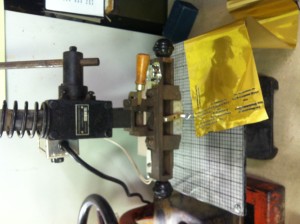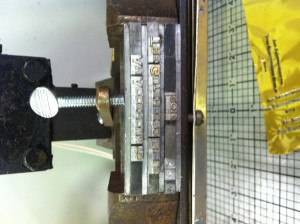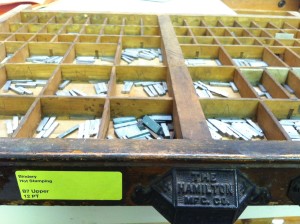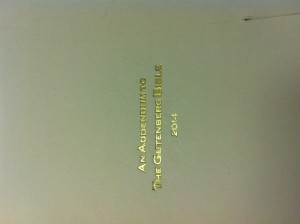Today I tried out different hot press foils on my Bristol 3-ply folio board. I want to order a magnesium plate using Textura font but that machine that can do larger areas needs a fix. But none the less, I know it works on my Bristol. I of course burned my self w the 300 degree block. 
Welcome to the Anthropocene!
The anthropocene is a name given to our time. Our time to drive Spaceship Earth as Buckminster Fuller so playfully and seriously wrote. An era, in my mind parallel to that of the microbial burst millions of years ago that changed climate so much that the planet became more habitable to evolve life as we know it. I am not…
Nick Golebiewski helps!
Today Nick helped me in all things IfThisThanThat. Check out Nicks drawing a day project nicks-lunchbox-service.tumblr.com
Artist Talk, June 13, 6:30-8:30 Center for Book Arts, 28 w27th St, NYC
So Cecile Chong, Dahlia Elsayed, Swati Khurana, Kameelah Rasheed, and I will be giving Artist Talks this Friday June 13, 2014 from 6:30-8:30 at the Center for Book Arts. We’ll be talking about the work we made at the Center’s Residency Program. Come check out my newest works: Tree, Addendum, Periodic Table Pop-ups, and a box-set of the Gowanus Canal. Below,…
colophon
I was granted a residency at the Center for Book Arts. Today, I worked on the colophon (the descriptor text of a letterpress project) for my Addendum using Weiss Roman and Weiss bold 10 point face. My favorite part of my colophon is the bibliographic reference. Much abridged as I used up nearly all the numbers in the case. Setting…
Deep Inquiry: Seeing Eye Dogs
Who picks up the Seeing-Eye-Dog poop?
Light Box
Thought Experiment: Imagine you have a box, and the inside is all reflective mirrors or perfectly white and you put a beam of light in there, and then seal it up tight (maybe a disco ball, so you can bounce a beam in, and as the light bounces around, you -speedy that you are- have a chance to seal the…
Metaphor is a Language Dandy.
When I decided to leave my PhD in cancer cell biology with a Masters, I had to write up my thesis and that is when I got stuck. My mother had uterine cancer at the time. I had all these issues with cancer research. But I wanted anyone with a high school degree able to understand my research. Cancer can be so frightening to those that have it, and the scientific argot is impenetrable.
In my undergraduate training, I learned the proper way to read a scientific article: read the abstract, look at the figures, then the materials and methods. The intro, results, and discussion sections –the expository writing– became fodder for discussion because that would inevitably have the author’s bias. By looking at the figures first, I could come to my own independent assessment before reading how the author saw the results. In this way, reading a scientific journal became a real dialogue, a sparing of 2 independent minds looking at the same data. I was to look at the facts and how the facts were obtained. I learned to read data. But I never forgot the first time I tried to read a scientific article– I only recognized the articles ‘the’ and ‘a’ – I slumped into ignorant despair thinking I would never become a scientist. And then, there I was in graduate school knowing my data was good, and that any good scientist could read the data, so I was adamant that the supplemental text be written in something more comprehensible to a non-scientist.
Of course, that was not standard style, certainly not for obtaining a ‘degree’ of learning (And of course, no one was ever going to read my uber-small reductionist capture of one possible reality –my little little thesis– if they had cancer. And no, I didn’t have that kind of wisdom.). After many quips by my advisor, he said, You write too much in metaphor. I had a kind of mental black out. I left. I left his office; I left science as I knew it. My world was both silent and screaming. What is a ‘signaling cascade‘? I demanded from my learned self. What is a ‘protein landscape‘? I screamed at the institution I loved. What? we name a new protein a ‘sonic hedgehog’ and that makes it non-metaphorical?, I said feeling cheated by my lifelong desire to be objective instead of an emotional — and therefore reduced to an irrational girl. I mean, I was fighting to be a scientist and my (female-body-carrying) emotion cum irrationality was certain to flunk me — though I was also becoming acutely aware that scientific careerism breeds a kind of self-satisfied irrationality successful. As my exampled sarcasm abated, I settled into the simplest question. What is red?
Really. What is red? What does red mean to you, and what does it mean to me, and what is the average color of red? (Say nothing of the cultural implications of red or the biological manifestations of color blindness or how/if a bumblebee sees red or if you even like red.) If I want to be a precise writer, do I need a color chart in this text to have you see the exact color and wavelength of red I am speaking of? Is it relevant? Will this make me objective?
We all have expert eyes that read all kinds of things besides words. Our senses are unstoppable data miners. But when the rays of light reflect back that red, what does your brain ‘see’? What phenomenon do you really experience. Inevitably, because you have different chemistry than me, you see something all together different. While we may be able to calibrate our language:perception skills to always choose the same colors, the fact remains, that we never see the same thing, or rather we have no way of proving we see the same thing. We use repetition to solidify language – to concur. It can be accurate, but it is never precise. It is metaphor. And when a metaphor is used enough, it becomes a kind of entrenched cliche we don’t even think about. It is practical, it is comfort food, and sometimes it can become a dominant paradigm in its unthinking status.
I know I am being painfully literal here. But I am trying to get at something fundamentally abstract. In this era of good-and-evil which is more like a banal-and-baneful existence that I still happen to be surviving, what is ‘truth’? How do we communicate this truth? In science, in politics, in religion, in art. And so I come back to metaphor. As an undergraduate at a 4-year technical school that had the audacity to call itself a university, I had 6 non-science classes in my degree. It wasn’t until 2009 that I read a book by Lakoff and Johnson that I got any reprieve.
“Metaphors We Live By” blew my mind. A little cog that had kept my gears bound, flipped out, and my mind whirred. What is up? What is feeling up? Up is a kind of vertical. Feeling up, is not lying down or dead. Up is a positional relationship to the world. To feel up, is to be up, to be using energy – to be living – in this world. Up. Little ‘ole up is a gigantic metaphor we take in stride the way we accept gravity will continue to pull us down. Every word we use is indeed a metaphor. oh my! Empiricism is not dead! it just has a long long long way to go! Like the equation for gravity – it is a close approximation, but is it correct? Not exactly. When is a word in lively consensus and when is a word dead, or worse, when is a word unwittingly part of a power structure?
My point here, is that my brain is one big equation. [This equals that. This is like that. This is in the same category. That is not. This smells like that. This reminds me of that. This is bigger than that. This is not the same, but it is also not different. This could be in this category or that category. This could be in both categories. This has a meta relationship. This has a micro relationship. This is tasty – this is good. I don’t like that –that is bad. This is what I thought 10 years ago and that is different than what I think today. I can see why that person sees it their way, but I don’t see it that way. I see it this way because my context taught me something else.] e.g. He is swimming upstream. Swimming upstream is harder than swimming downstream. He is doing something hard. Like a geometry proof, metaphor works like this: if a=b and b=c, then a=c. Our senses capture our environment. The ecology of our nested relationships in the world are drawn with metaphor.
My point also, is your brain is one big equation. Your equation is different than mine.
Sometimes we gather new information that changes the equations in our brains. Sometimes we gather it and don’t know how to incorporate it into our already convoluted equations and it is lost. Sometimes we gather it and isolate it in the realm of impossibility because our equation is so solidified on its neuronal looping that it is an impossible idea. And sometimes we don’t even process information that our bodies receive because we are not prompted by previous context to give them meaning or to even grant sensible what our senses collect.
This is why I love dandy’s. This is why I aspire to be a quaintrelle. This is why I love metaphor. Metaphor is one big dangling modifier of reality. It doesn’t have to be incorporated into our equation, it just flies a tangent off our circular looping. And there you have it, an association, rather than a truth. Something that conjures a connection without pretending to be truth. Something that is alive and present, something that is newly made, something that brings things together – something endearingly vital. Something that derives meaning in our constellated lives. Even if it is way off base, it opens the dialogue. New metaphor is the closest thing we have to a contemporary in language and therein lies the opportunity of a palpable living democracy through personal expression.
I’m in love with Oscar Wilde because he could hold 2 different things at the same time without an equal sign and still be truthfully present in the paradoxes of his world. I am just sorry they treated his syphilis with doses of mercury. Modern science does help us know more about how things like mercury affect the body, but modern science is like us, it is a human product, and while it tries very hard to pursue a kind of truth, it has to build on metaphor like everything else. Science is poetry too.
jlw23Aug09





